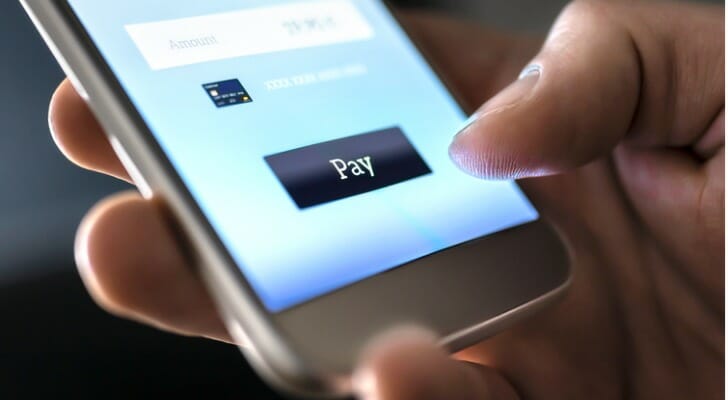If you have a bank account, there are certain federal rules in place that are designed to protect your money. Regulation E is one of the most important. This federal regulation governs electronic fund transfers (EFTs) between things like checking and savings accounts. If your bank account is targeted for fraud, Reg E is there to help.
If you need help organizing your assets in different types of accounts, consider working with a financial advisor.
What Is Regulation E?
Regulation E is the means by which the federal government implements the Electronic Fund Transfer Act (EFTA). Passed in 1978, the Act is designed to offer consumer protections for electronic fund transfers and remittance transfers.
Financial institutions that facilitate electronic fund transfers are subject to Regulation E rules. The regulation also affords consumers certain rights when disputing unauthorized transactions and limits financial losses related to fraud.
What’s Covered Under Regulation E Banking Rules?
Regulation E applies to a wide range of electronic fund transfers that either debit or credit customer accounts.
The types of EFT transactions covered by Regulation E include:
- Point-of-sale (POS) transfers
- ATM transfers
- Direct deposit transactions
- Automated Clearing House (ACH) transfers
- Debit card transactions
- Telephone transfers, including electronic bill payments
- Person-to-person payment services
Essentially, if you use your debit card to shop online, send payments to friends from your bank account through a service like Zelle, or withdraw cash at ATMs, Regulation E applies.
There are, however, some exceptions that are not covered under Regulation E banking rules. Specifically, those include:
- Credit cards
- Wire transfers
- Transactions involving paper checks
Keep in mind that credit cards have their own regulatory guidelines that govern what card issuers can or cannot do, and what protections consumers have from fraud or unfair practices.
How Does Regulation E Protect Consumers?

The main function of Regulation E is to protect consumers against financial losses stemming from unauthorized transactions and fraud. Reg E gives you the right to dispute eligible transactions with your bank. It also limits your liability for fraudulent transactions.
So, say that you see a debit card purchase for $100 on your bank statement that you don’t recognize. You could dispute that charge with your bank to have the money returned to you. The amount of the charge that you’d be liable for would depend on how quickly you reported the loss.
Regulation E specifies several rules for governing fraud liability as it relates to debit cards. If you:
- Report a lost or stolen debit card before someone uses it, you’re not responsible for any fraudulent transactions.
- Report a lost or stolen debit card after someone uses it, what you’re responsible for depends on how soon you reported it.
If someone uses your bank account number to make a fraudulent purchase or withdrawal, but your card is not lost or stolen, you aren’t responsible for unauthorized transactions if you report the loss within 60 calendar days after your statement is sent to you.
So, how much could you be on the hook if someone uses your debit card without your consent? Here’s what Regulation E dictates.
| When You Report a Lost or Stolen ATM/Debit Card | Maximum Loss |
| Before unauthorized charges are made | $0 |
| Within 2 business days after you learn about the loss or theft | $50 |
| More than 2 business days after you learn about the loss or theft, but within 60 calendar days after your statement is sent to you | $500 |
| More than 60 calendar days after your statement is sent to you | 100% of the money taken from your ATM/debit card account |
How to Dispute Debit Card Transactions With Your Bank
If you believe that someone has made an unauthorized transaction from your bank account, Reg E gives you the right to dispute the charge. The process for disputing fraudulent charges may vary from bank to bank, but it typically involves the same steps. Note that there’s a different process for disputing credit card transactions.
First, you’ll need to figure out who to contact to initiate a Regulation E banking dispute. You can start by calling the customer service number on the back of your debit card. Or you may want to go to a branch in person if your account is at a traditional bank.
Next, you’ll need to provide details about the transaction you’re disputing. The bank will likely ask for the following:
- Transaction date
- Transaction amount
- Where the transaction occurred
- When it posted to your account
- How it occurred (i.e., lost or stolen debit card, stolen account number, etc.)
Your bank might allow you to initiate a bank account or debit card dispute over the phone, though some may require you to go to a branch to fill out a dispute form in person. Depending on the bank’s policy, you may be issued a provisional credit for the disputed amount right away.
Keep in mind that the bank could reverse the credit later if an investigation finds that the disputed transaction doesn’t qualify under Regulation E banking rules or you’re fully liable because of when you reported it. The bank should tell you how long you can expect it to take to investigate the claim.
How to Protect Your Bank Account Against Fraud
Bank account fraud can be costly if you’re slow to notice and report it. Exercising vigilance with your bank accounts can help you to reduce your odds of being targeted for unauthorized transactions.
Here are a few helpful tips for keeping your debit card and bank account safe:
- Choose a unique username and password for online and mobile banking.
- Consider enabling multi-factor authentication or biometric identification when logging in through your mobile device.
- Avoid logging in through unsecured public Wi-Fi networks.
- Don’t share your PIN number with anyone.
- Consider adding your card details to a secure mobile wallet app that encrypts your information when using your card to pay.
If your debit card goes missing, you can call your bank right away to have it canceled. If you can’t get in touch with your bank, you may be able to lock your card through online or mobile banking. Locking your card can prevent anyone from using it to make unauthorized purchases or cash withdrawals.
History and Purpose of Regulation E
Regulation E was introduced in 1978 as part of the Electronic Fund Transfer Act (EFTA). At the time, the financial industry was undergoing a rapid transformation. ATMs, direct deposit, and electronic bill payment offered new levels of convenience, and risk. Consumers needed clear guidelines for resolving errors or preventing fraud tied to these new banking technologies. It did this by setting limits on consumer liability for unauthorized transactions and establishing procedures banks must follow when a customer disputes a charge.
Regulation E has evolved to keep up with developing financial technology. In 2010, the Consumer Financial Protection Bureau (CFPB) issued updates to extend Reg E protections to remittance transfers, international money transfers often used by immigrants sending funds to family members abroad. More recently, questions around peer-to-peer payment apps and online banking platforms have prompted additional guidance on how Regulation E applies to digital services like Zelle and PayPal.
Regulation E is designed to work alongside other consumer protection laws. For instance, the Truth in Savings Act requires financial institutions to disclose interest rates and fees clearly, while the Fair Credit Billing Act protects consumers from billing errors and fraud related to credit cards. Together, these regulations aim to make it safer for consumers to participate in an increasingly digital financial world.
Bottom Line

You might not give much thought to federal banking rules and regulations but it’s important to know that they’re always there working behind the scenes to keep your money safe. Should your bank account be subject to fraud, Regulation E can limit your losses for transactions you didn’t authorize.
Banking Tips
- Consider talking to a financial advisor about the best places to keep your money and how to protect your accounts against fraud. If you don’t have a financial advisor yet, finding a financial advisor doesn’t have to be hard. SmartAsset’s free tool matches you with up to three vetted financial advisors who serve your area, and you can interview your advisor matches at no cost to decide which one is right for you. If you’re ready to find an advisor who can help you achieve your financial goals, get started now.
- Regulation E isn’t the only thing protecting your bank account. Assuming that you keep your money at an FDIC-insured bank, your accounts are also safeguarded against losses stemming from a bank failure. The FDIC insures deposits up to $250,000 per depositor, per account ownership type, per financial institution. While bank failures are a rarity, it’s good to know that your money won’t just disappear should your bank experience significant financial troubles. The National Credit Union Administration (NCUA) provides similar protection for accounts held at member credit unions.
Photo credit: ©iStock.com/AsiaVision, ©iStock.com/Tero Vesalainen, ©iStock.com/Fly View Productions
